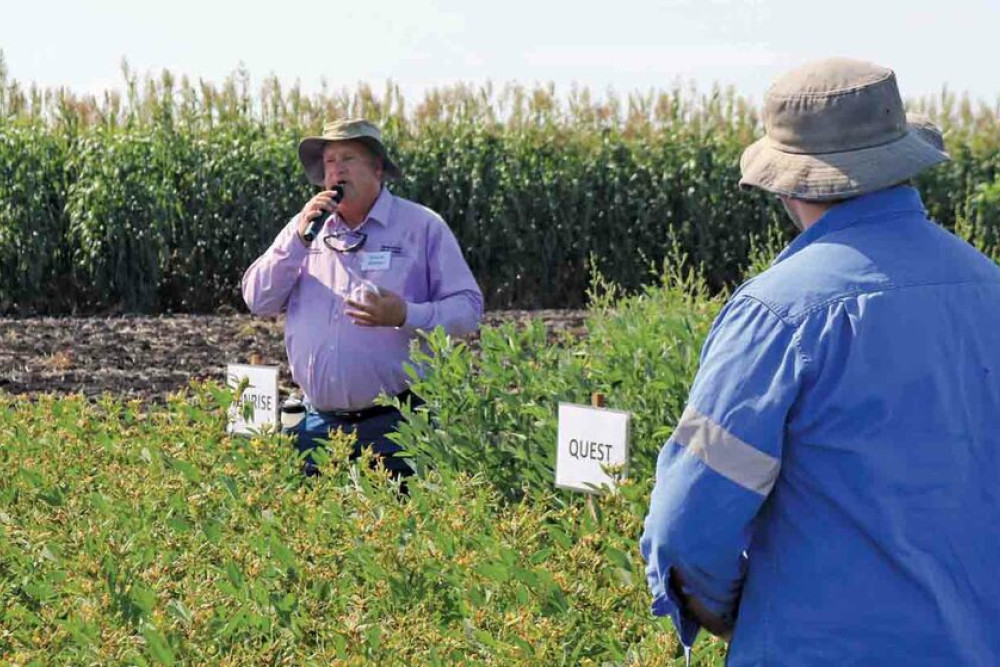Agricultural
7 March, 2024
Pigeonpea trials gain momentum
A field walk was held on Friday, March 1, at the Tosari Crop Research Centre at Yandilla, providing growers with the opportunity to inspect the pigeonpea trial lines that are a part of Queensland’s Department of Agriculture and Fisheries (DAF) four year initiative program which recognises the potential of moving pigeonpea beyond its current role as a refuge crop for cotton, into a key summer pulse crop in Australia.

Cajanus cajan, more commonly known as pigeonpea, is a shrubby, drought tolerant, fast-growing legume.
It originated in India, and most of the breeding work done over past years has been by Indian researchers.
In Australia, pigeonpea is mostly used as a refuge crop for cotton growers, providing a nursery for insects, particularly Helicoverpa.
The Grains Research and Development Corporation (GRDC) has recently partnered with the DAF, and the Woods Group, to explore pigeonpea as a new broadacre summer pulse crop option in Queensland and northern New South Wales.
Pigeonpea was grown in Australia in the late 1980s but with little success.
The DAF is again interested in pigeonpea for a number of reasons.
“If you think about the role that chickpea plays in the winter cropping cycle, in rotation with wheat, we don’t really have anything like that for summer crops in the dryland, broadacre areas,” principal research scientist at DAF, Bruce Winter said.
“There’s a range of pulses, particularly mungbeans, soybeans on the coast, peanuts on the red soil and further north, but all of those crops don’t do well under tougher, dryland conditions.
“They’re more for higher rainfall areas or under irrigation, so we’ve identified a niche here that should be filled,” he said.
The DAF also recognises the current demand for pigeonpea grain in India.
More than 85 per cent of the world’s pigeonpea is consumed there.
At the moment, demand for pigeonpea, or toor dal, as it is referred to in India, is outpacing the country’s domestic production.
At the Tosari field walk, growers were able to view the new lines on trial, including a new super quick variety.
This variety has only become available over the last decade, from the gene bank at International Crops Research Institute for the Semi-Arid Tropics (ICRISAT) in Patancheruvu, India.
Mr Winter described this variety as very different from the old, traditional types of pigeonpea.
This is owed to the fact that in today’s farming, the agronomy is better, the markets are more accessible, and the chemistry, particularly around insecticides and herbicides, has improved greatly over the last couple of years.
Most of the super quick varieties are flowering around 45-50 days, and are physiologically mature at about 100-105 days, making the crop harvestable at 110 days.
Although the super quick material is able to hold its maturity, the suggested planting period is from October through to early January.
Other varieties on trial include sunrise, quest, KP 82 and KP 15.
There is currently little, if any, pigeonpea being exported from Australia, but Mr Winter estimates that world prices are about 800-1000 US dollars per tonne, exporting into India.
Yash Chauhan, a principal scientist at DAF who is based in Kingaroy, explained that India imports almost 3.5 million tonnes of pulses every year.
Chickpeas, lentils and pigeonpeas are among the top imports.
Australia is one of the only developed countries able to produce pigeonpea, as the tropical and subtropical areas are vast, and prove ideal for the crop.
Not to mention the modern farming techniques and machinery.
In comparison, the Indian pigeonpea grows tall, and is largely picked by hand.
With the ideal environment and systems, Australia would be a tough contender in the high quality market with mass amounts of pigeonpea production.
Other speakers on the day included entomologist Trevor Volt and weed scientist Troy Frederiks who spoke about pest control.
General insects will pose one of the key problems with growing pigeonpea, and phytoplasma is also something to be aware of, Mr Volt said.
“A leafhopper vectors the disease, it feeds on the plant, the disease then replicates on the plant, and it stunts its growth,” Mr Volt said.
“If you get one that’s infected with the disease before flowering, it won’t flower properly, and won’t pod properly.
“We’ve seen it around for a number of years.
“Back in 2017, some soybean paddocks on the Downs, were wiped out by phytoplasma.
“We did surveys in mostly mungbeans at the time, but I was looking at pigeonpea refuges, and we were getting up to 20 per cent incidents in those refuges.
“As you know with sunrise [variety], they’re in the ground for a lot longer, and we suspect that they’re a lot more susceptible to the disease.
“But with these field trials, using the more shorter, determinate varieties, we’re only getting 1-2 per cent,” Mr Volt explained.
The major disease in pigeonpea in India is the pigeonpea sterility mosaic virus which is infected from a mite.
Fortunately, the virus and the mite, are not in Australia.
A DAF representative said this is only the start of the pigeonpea industry in Australia.
“As we grow more, we learn more, as we do the science and the industry starts to grow, we focus on the market needs of the crop, and that will likely launch into a modest breeding program,” the representative said.
Although a couple years away from larger commercial planting, the DAF aims to build a new pigeonpea industry in Queensland to provide growers with a profitable broadacre summer legume crop, and develop new export markets to Asia, building on the success of the mungbean and chickpea.
The next field walk is March 8 at Warra and growers will be able to view the new, experimental pigeonpea and mungbean trial lines.
For more information about the pigeonpea industry in our region, contact Bruce Winter on 0419 652 243.


